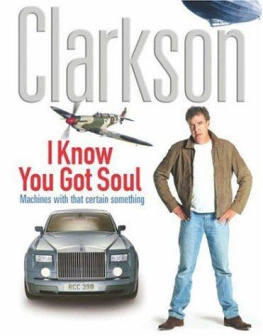Porsche Carrera GT
There have been a handful of scientific breakthroughs in the past few weeks that I suspect may have slipped under your radar.
A couple of Dutch boffins, for instance, have developed a new kind of fabric that could be used as a television screen. So pretty soon youll be able to watch Matrix Reloaded on your tie.
Then we have the British satellite that can spot rainfall and vegetation growth in Algeria. As a result, farmers there will be able to bring some shock and awe to the locust breeding grounds before the insect sex even takes place.
Or what about the vibrating shoes that have been developed in America? Apparently these compensate for a loss of balance in the elderly and will cut the number of falls and broken hips.
Best of all, we have the 2580 service on your mobile. Dial the number, hold the phone against a speaker and within 30 seconds, for just 9p, youll be sent a text saying what the song is and who its by.
So now you can wave goodbye to the misery of trying to find out what it was you heard on the radio by attempting to sing it to your friends. You must have heard it. Its brilliant. It goes ner-ner-ner de-dum-dum on the beach.
Even China is riding the techno wave. We were told this week that the sheer weight of skyscrapers being built in Shanghai is squashing the rock on which the city is founded.
And we mustnt forget that extraordinary dam that will provide limitless power for everyone until the end of time, or their rocket, which next week will keep the red flag flying in space.
Nearer to home, scientists have developed a heat-resistant plastic which theyre using to make a light that goes on in a handbag every time its opened. Wonderful. No more standing around on the doorstep for 15 minutes while our wives rummage for the keys.
And then theres the world of computers. Seismologists have been able to work out just how big the tidal wave will be when Tenerife splits in half and falls into the sea. Very, seems to be the answer.
Theyve even been able to determine why tortoises on the Galapagos Islands are all mental. It seems there was a genetic bottleneck 100,000 years ago when a volcano went off, and only the biggest, daftest tortoises survived.
Its astonishing. We can trace a tortoises family tree without trawling through parish records and looking at gravestones. We can watch moving pictures on our clothes of locusts dogging, safe in the knowledge that our mothers have not fallen over while we werent looking.
And theres so much more. We can genetically modify crops, we can measure the smell of cheese, we can track stolen cars from space and teach our television sets to skip the adverts. We can do anything. We are invincible. And yet we are still being propelled from place to place by a series of small explosions.
It doesnt matter whether you drive a McLaren or a McDonalds delivery van, you are still relying on exactly the same technology that was dreamed up more than 100 years ago. In some ways this is a good thing, because when change is slow theres a chance for engineers to plane away at the rough edges, leaving you with something close to perfection.
If there had been a completely new type of technology invented every 20 years or so, none would have been refined to the same extent as the internal combustion engine we have now.
And the most refined, most planed-away, most astonishing engine I have ever encountered is currently to be found sitting in the middle of Porsches new Carrera GT. This is 100 years of human achievement crammed into three cubic feet of titanium, magnesium, aluminium and raw, unadulterated, visceral, screaming power.
Youre told, before you set off, that in no circumstances should you apply any throttle at all while engaging the clutch. The mountain of torque, apparently, would catapult you and your 320,000 hypercar into the nearest piece of foliage.
The Porsche engineers talk about the clutch pedal as though its the trigger for a nuclear bomb. It may as well be.
The engine started out as a 5.5-litre V10 that was all set to be used in the back of a racing car at Le Mans. But a last-minute rule-change favoured smaller turbo units, so the programme was scrapped.
Nearly. In fact, Porsches racing division handed over its stillborn engine to the road-car people, who had to worry about emission regulations. That meant adding a third piston ring, which meant fitting longer pistons, which took the engine up from 5.5 to 5.7 litres.
But the ceramic clutch remained. The Skunkwork stealth materials remained. The racing power remained too, all 612 brake horses of it. And you should hear the noise this thing makes. Its like driving around with the bastard love child of Jaws and Beelzebub in the boot.
Strangely, though, its not the engine that impresses most of all about the Carrera GT. Its the weight. Unlike any other road car ever made, all of it the body, the tub, even the support struts for that monster V10 are made from stuff that sure as hell wasnt in the periodic table last time I looked.
The result is an extraordinary lightness. The targa-style roof, for instance, lifts out in two panels, each of which is light enough to be carried away by a strong ant. The seats weigh less than a bag of sugar. This car is so light I would be loath to leave it parked in a high wind. Certainly youd feel guilty driving it after a big lunch.
The result is simple. Mix an anorexic body with a heart made of pure fire and you are going to go with a savagery thats hard to explain.
Ive been in some pretty fast machinery over the years, but nothing prepared me for the neck-snapping, spleen-bursting, hammer-blow explosion of power that came the first time I floored the Carreras throttle.
I was on an arrow-straight forest road in eastern Germany and it was like I was caught up in a Doctor Who special effect. Nought to 60 was dealt with in 3.9 seconds. Nought to 100 took 8, and then it really started to fly. Even at 175 there was no let-up, no sense that the engine was having to fight the headwind. There was just more power, more acceleration, more speed and more of that amazing noise.
What made the experience even more bizarre was the way the engine lost its revs between gear-changes. Because the ceramic clutch is so light, theres nothing for it to fight. You just get that wawawawa, like you do from a Formula One engine.
Now, we have seen this kind of blood-and-guts stuff before, from Ferrari and McLaren and even some of the new boys like Pagani and Koenigsegg. But the Porsche feels different from any of them.
It feels finished. The quality of the body is as good as youd expect from a Toyota Corolla and inside theres exactly the right blend of luxury, style and weight saving. Ferrari just tends to nail a speedo to the dash and leave it at that. Pagani uses too much chintz. The Carrera is perfect.
And there is no doubt that from any angle it is utterly beautiful. I had a long discussion recently with a friend about the difference between art and design. And without wishing to sound like Alan Yentob, the Carrera seems to sit at a point where the two disciplines meet.
It looks like the result of a liaison between Henry Moore and Isambard Brunel. It is engineering at its artsy-fartsy best.
The next time a car comes along that is better than this, it will be using a completely different technology. Because when youre limited to what we have now, this, quite simply, is as good as it gets.
Sunday 12 October 2003
Dont Stop Me Now
Don't Stop Me Now
Honda Accord Tourer Type S
With the audience figures for Radio 1s Breakfast Show in free fall, bosses have decided to replace the DJ Sara Cox with someone else whose name escapes me. The Queen, probably.













